Myong, BioE Undergrads Expose Middle Schoolers to DNA/Cell Measurement
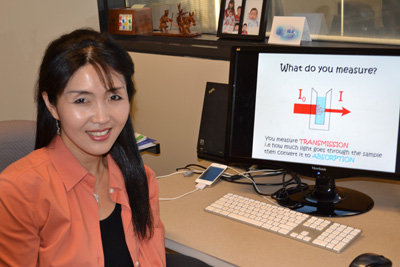
Bioengineering researcher Sua Myong
October 31, 2012
On Wednesday afternoons, a number of Illinois Bioengineering undergrads can be found at Jefferson Middle School teaching seventh and eighth graders about science. The brain child of Bioengineering professor Sua Myong, this year-long, after-school outreach program funded by the Center for the Physics of Living Cells meets once a week to expose students to techniques used to measure things in cell biology. Says Myong: "I want to give the students an idea that biology can be measured quantitatively. This can be very beneficial to different research and biomedical areas, such as disease diagnosis and drug design."
Myong asserts the goal of her program is to make science "fun and approachable" and to "build confidence that this is not really far from what they do in everyday life." Along with audio visuals, her program will offer lots of hands-on activities, because, according to Myong, "Science becomes real to them when they engage in hands-on activities; so we are going to make, visualize, and measure biological materials."
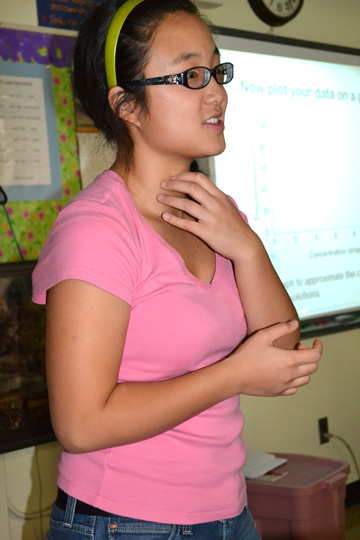
BioE undergrad Linna Guan explains measurement technique to Jefferson Middle School students participating in Myong's after-school program.
To help with the program, Myong has recruited some undergraduate Bioengineering students who are excited about outreach activity; they will not only be team teaching with her, but helping her develop the lesson plans and the accompanying activities. These undergraduate students have already taken Myong's "Cellular Bioengineering" course last year. "I think that the undergrad students are going to come up with many creative ideas, so I am looking forward to fun interactions with them. I don't have to motivate them; they are already motivated to participate."
Myong reports that many activities will deal with DNA, which lends itself to measurement. "I do a lot of DNA research, and there are a lot of cool techniques that I can explain by using DNA as a bio molecule. We can measure DNA length, concentrations, and the temperatures at which the double-stranded DNA melts into single-stranded DNA. Each lesson will be accompanied by a hands-on activity through which the students will make measurement." Even the snacks are going to reflect their lessons; one snack they plan to use is Twizzlers, because "the twisted version of Twizzlers look just like the double helix of the DNA, so we will unzip the Twizzler to mimic the unwinding of DNA."
Some examples of first semester lessons working with DNA will include DNA concentration, melting temperature, length, sequencing, polymerase chain reaction, and recombinant DNA techniques, as well as forensic science; during the second semester, they will also look at topics about cells, such as organelles, stem cells, cytoskeleton, and both gene and neuro therapy. Myong intends to try to link each of the topics to the biomedical field, specifically diseases: "We are going to try link the lessons to human disease topics. Through the little questions at the end, we are going to try and make them think about, 'How can this be useful for disease detection or treatment of disease?'"
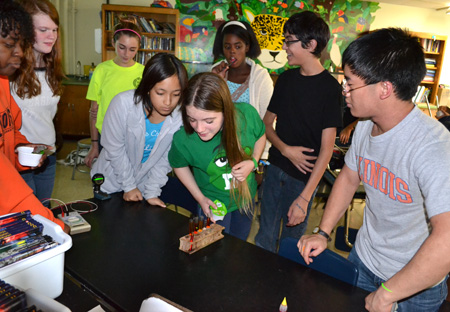
Jefferson Middle School students and Illinois BioE sophomore Thomas Deleon (far right) do hands-on activity to measure the transmission of light through solutions which represent various concentrations of DNA.
Myong reports that her passion for early science education and communicating her research to youngsters came from "interacting with my own kids, thinking about the ways and vocabulary that they will understand, because I want them to understand a little bit of my research too. This way, they also understand why Mommy spends a lot of time in the lab talking with students." She also reports that her ability to distill her research down into something kids can understand was perfected through interactions with her children's friends, who would ask, "I heard you were a scientist; what do you do?" So she worked on explaining it in language they could understand.
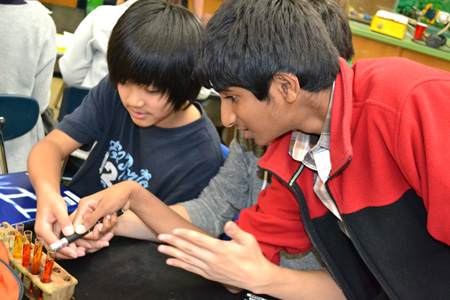
Jefferson Middle School students use laser to measure light transmission during a hands-on activity.
Myong relates an anecdote about one of her first experiences realizing that her work could appeal to kids. A while ago, she did a demo for some second grade kids who visited the Institute for Genomic Biology. She recalls being in a dark microscope room where lasers are used to illuminate surfaces to look at florescent molecules:
"So these kids came into the microscope room, and when I turned the laser on, they became all excited. I thought, "Whoa! All of these little boys and girls jumping up and down from excitement!" But it was a moment of spark. When the lasers came on, they responded, 'Wow, this is the coolest thing; I get to play with lasers, and lasers come through optics and bounce on mirrors!' For some, such an experience will be a life-changing experience."
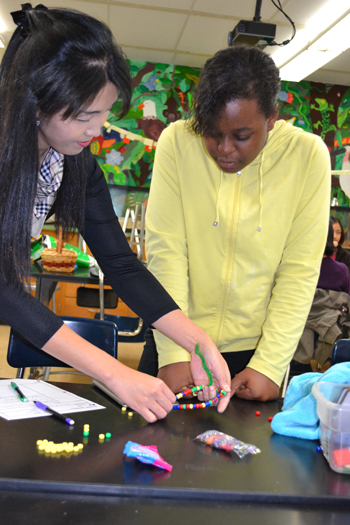
Sua Myong works with Allegra Amos during lesson on plasmids.
Why 7th and 8th graders? Myong's eyes were opened regarding the need to target this age group when her daughter got into high school.
"What she told me kind of shocked me. A lot of girls in 9th and 10th grades are already losing interest in math and science. They perceive these studies as something reserved for the special few. So I thought that maybe high school was too late to reach out…Maybe middle school would be where they are more open to ideas and seeing more possibilities for their future careers."
For one eighth grader, Allegra Amos, the program may have tipped the balance in favor of bioengineering over a possible career in astronomy. Her favorite activity? Forensic science and the activity where they cut DNA strands to match those on the crime scene. Regarding the program, she shared: "This is a really fun class. I recommend it for anybody that likes science or bioengineering."
Myong was invited to implement her program at Jefferson by science teacher Jennifer White, herself an Illinois alumnus in cell biology. White believes the students are enjoying the challenge.
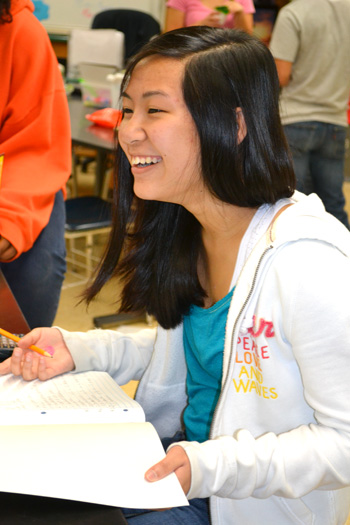
Jefferson Middle School student enjoying one of the sessions.
"When it first started, I was a little hesitant. I was unsure if it would be over their heads, if they would be overwhelmed, so I really picked the highest of the high science students to be in this. As soon as the first lesson started, I saw that, with the hands-on activities, the students were instantly enthralled by it. These are kids that maybe aren't getting [challenged] within the regular curriculum; it's a lot of stuff that they already know, and teachers will add enrichment to that, but they're not necessarily being pushed as far as they can be pushed. So this gives them an opportunity outside of school to really explore. And I don't think they always understand it a hundred percent in there, but they're thrilled to be a part of something that is hard for them and that challenges them and really makes them think. So it's been very positive feedback. I talked with a couple after the first meeting just to get some feedback on what they were feeling; everyone I spoke with was really positive about it and excited."
Along with communicating the fun aspects of her work to the youngsters, in the back of Myong's mind is a hope that through the outreach, she might be influencing some of them to choose science as a career: "I don't know what they are going to become later on, but they would have tasted what it means to be a scientist, a bioengineer."
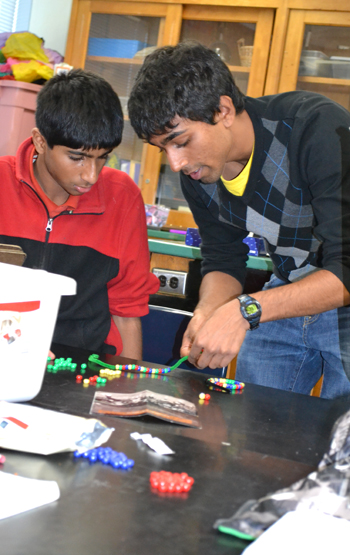
BioE student Manu Kumar (right) works with student during hands-on activity about plasmids.
White agrees that the program could steer some of the kids toward careers in cell biology: "I think that it definitely could; it kind of opens up their eyes to what's out there. Our 7th grade does a really nice unit on the cell and genetics, but it's pretty superficial, like what an average middle schooler should be able to understand. So then this obviously takes that to the next level and makes those connections. And they get to see what real graduate students and Ph.D. students are working on and inspire them in a lot of ways."
The program has also been a positive experience for Myong's Bioengineering protégés. Manu Kumar, who has been considering teaching, enjoyed the experience. "Walking in, I was like, "Oh, I don't know how this is going to go.' It was kind of weird. I didn't think I'd be able to teach them. I think they hopefully learned a little bit. Or maybe if they see it again, they can at least say, 'Oh, I've seen this before, and I kind of know what's going on,' so even that would be good."
Author/photographer: Elizabeth Innes, Communications Specialist, I-STEM Education Initiative
More: 6-8 Outreach, BioE, CPLC, Faculty Feature, Jefferson Middle School, Women in STEM, 2012
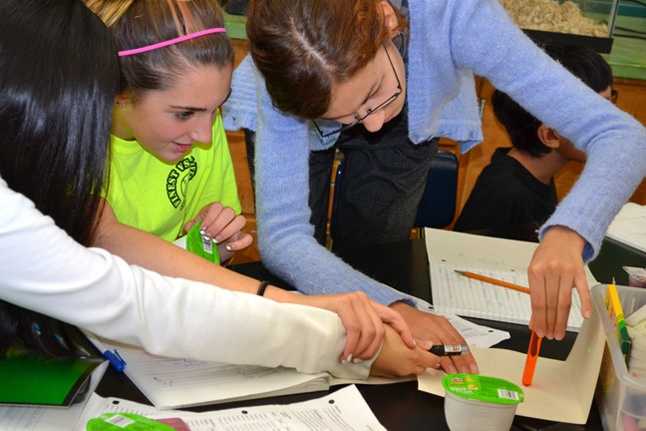
Three students in Myong's after-school program use a laser to perform measurement during a hands-on activity.













.jpg)
















